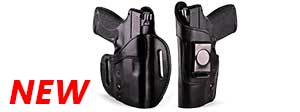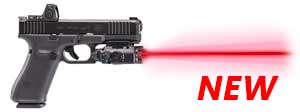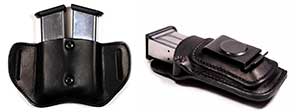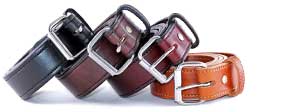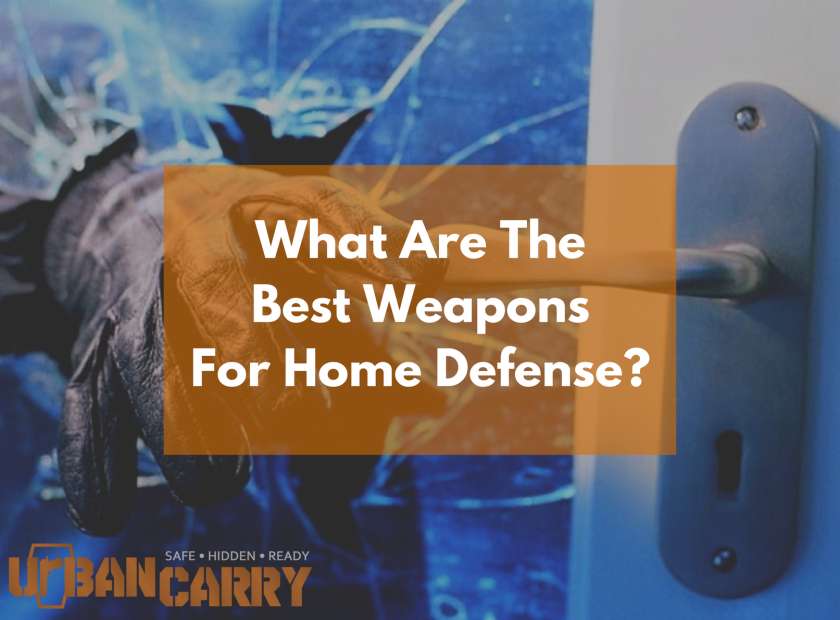Best Guns for Home Defense
Home Defense Firearms
Having the ability to protect yourself and your family in the event of a home invasion offers a peace of mind that is priceless. However, if you want to truly ensure that you are prepared for the worst of situations, choosing a firearm at random and keeping it in your home is simply not enough.
In this guide, we'll cover all of the important considerations when choosing a home defense firearm as well as how you can go about making sure you are prepared to defend yourself if the nightmare of a home invasion ever becomes a reality.
The Importance of Choosing the Right Home Defense Firearm
When it comes to home defense, not all firearms are created equal. For example, some calibers are simply too small to reliably put down an intruder even if you manage to get several shots on target. Other firearms may not have a large enough magazine capacity to be practical in a home defense scenario, may be too bulky to maneuver through your home, may be too inaccurate to be reliable, and the list goes on.
When selecting a firearm with intention of using it as a home defense weapon, it's essential that you look at the weapon from a home defense perspective. This is what we will do in this guide when considering home defense rifles, shotguns, and pistols.
Home Defense Rifles
Of the three types of firearms (rifles, shotguns, and pistols) rifles are the least commonly used weapon for home defense purposes. However, certain rifles do offer advantages that can be useful in home defense scenarios. One big advantage of rifles is their accuracy.
Regardless of your level of training, you're likely going to have an easier time putting rounds in the target with a rifle than you will a handgun. Rifles are steadier and make it easier to hold the sights on target. While range is rarely a concern in home defense applications, rifle rounds are also much more accurate at longer ranges than pistol rounds or shotgun rounds.
Another advantage of rifles for home defense is their magazine capacity. If you choose a rifle such as an AR-15 or an SKS, the standard magazine will hold 30+ rounds - which is likely more than five times the magazine capacity of the average shotgun and at least twice to three times the magazine capacity of the average handgun. While you should never need 30+ rounds to stop an intruder, it can be comforting to have them available in case you end up in a full-blown gunfight.
With that said, there are some serious drawbacks to using a rifle for your home defense weapon. For one, they are extremely loud and are likely to obliterate your hearing the first round you fire in an enclosed area such as will be the case indoors.
Rifles are also bulky and more difficult to maneuver through hallways and around tight corners than handguns are. The biggest drawback to using a rifle as your home defense weapon, though, is over-penetration. Pistol and shotgun rounds will typically stop when they hit a wall.
Rifle rounds, however, will often go through several walls like hot butter. With every rifle round you fire indoors, you risk hitting someone a few rooms over or even your next door neighbor.
Still, if you live somewhere where over-penetration is not a concern and you are not bothered by the bulkiness and noise of rifles, then a semi-automatic rifle can make for a very capable home defense firearm. One thing is for sure - if you are in an actual gunfight or facing multiple attackers, there's no better weapon to have in your hands than a semi-automatic, high-capacity rifle.
Home Defense Shotguns
Next to handguns, shotguns are the most common type of weapon for home defense applications. One benefit of shotguns is their versatility. Unlike rifles and handguns which are designed to send one type of bullet downrange and one type only, shotguns can be loaded with a wide range of rounds that drastically change the firearm's function.
Slugs can essentially turn a shotgun into a high-caliber rifle and buckshot can provide plenty of stopping power and a little bit of spread to make up for inaccuracy. You could even load your shotgun with birdshot in order to avoid killing an intruder on the first shot.
It's important to note, though, that one of the main reasons people choose shotguns as their home defense weapon is largely based on a misconception. That misconception is that shotgun pellets spread so far out that you don't have to actually aim to hit your target.
The reality is that at close ranges, the spread on most shotguns is minimal. Even if you are using a load with a wide spread such as birdshot, the pattern of the pellets at close range still isn't likely to be any larger than a basketball.
Buckshot - which is a much more capable and common home-defense load - will spread even less, and slugs offer no spread at all. In short, even when using a shotgun, accuracy is still of the utmost importance.
One other drawback of shotguns that is important to consider is magazine capacity. While some shotguns have a drum or magazine that is able to hold a considerable amount of rounds, the vast majority of shotguns are tube-fed and typically hold about 5-8 rounds.
Shorter shotguns such as the kind that are more practical for home defense situations will hold even less. To make matters worse, if you do run out of ammo in a tube-fed shotgun, reloading is going to be a much more time-consuming process than changing the magazine in a rifle or pistol.
With all of that said, shotguns are still a fine home defense weapon and are trusted by people the world over for keeping their home safe from intruders.
Handguns for Home Defense
Handguns are by far the most common weapon for home defense purposes. For one, they are easy to store and can be accessed at a moment's notice. Handguns are also easy to maneuver indoors, enabling you to quickly clear doorways and make your way throughout your home without the size of your weapon holding back your maneuverability.
As with shotguns, there is little risk of over-penetration when firing a handgun indoors as pistol rounds typically do not have enough energy to penetrate through multiple walls. Unlike shotguns, though, magazine capacity is not nearly as much of a concern with handguns, as many double-stack pistols are able to hold fifteen rounds or more. At close range, handgun rounds have more stopping power than most rifle rounds even, and though they might not have the stopping power of a buckshot load they are still more than capable of neutralizing a threat with a single, well-placed shot.
Handguns do have a couple of drawbacks in that they are more difficult to accurately aim than shotguns and rifles and their range is more limited than rifles. However, at the close ranges you almost always encounter in home defense scenarios, both of these drawbacks are much less of a concern.
One important consideration when using a handgun for home defense is where and how you store your weapon. Obviously, a weapon that is locked up in a safe isn't going to do you much good in a situation where every second counts.
At the same time, though, simply storing your weapon loose in a drawer is neither safe nor practical. For one, there is the risk that you could accidentally discharge the firearm when shuffling through the drawer for any other items you might be storing there.
Also, since your weapon is free to move around in the drawer, there's no way to know with 100% certainty where exactly it is going to be located or how it is going to be oriented. While it may only take a second or two to find your weapon, those couple seconds can make a big difference.
If using a pistol as your home defense weapon, we strongly recommend you store the weapon in an off-body gun holster such as our Stoker Off-Body Holster. This holster is designed to secure handguns in place in a wide variety of locations such as in a drawer or underneath your desk. With an off-body gun holster, you can rest assured that your weapon is both easily accessible and secured against the possibility of accidental discharges.
Which Pistol Caliber is Best for Home Defense?
One of the most common questions regarding home defense handguns is which caliber is best. While many people have very strong opinions about this topic, the reality is that there are a wide range of calibers that are plenty capable of putting down an intruder. In the end, choosing a weapon that you are comfortable with is much more important than worrying about the stopping power and ballistics of its caliber.
With that said, there are some extremes on both ends of the spectrum in regards to caliber that are not ideal for home defense situations. For example, .22 rimfire pistols may be quiet and easy to shoot, but they simply don't have enough stopping power to reliably put down an intruder.
While a .22 round may kill an intruder eventually, it isn't likely to stop them in the heat of the moment. In fact, if an intruder is pumped up on adrenaline or drugs they may not even notice that they've been hit when shot with a round this small.
On the other end of the spectrum, some rounds are too large to be practical for home defense situations. A .500 magnum may have enough stopping power to put down a charging grizzly, but the recoil from a round this large will likely make it impossible to accurately put multiple rounds downrange.
When choosing a caliber for your home defense handgun, it's best to stick with the middle ground. If you still aren't sure which caliber to choose, you can't go wrong with one of the main four: .380, 9mm, .40, and .45.
Other Important Considerations
Choosing an appropriate firearm is only one half of the home defense equation. In most cases, the factor that is much more important than the firearm is the training and preparedness of the person behind it. Start by deeply familiarizing yourself with your weapon. Get comfortable drawing your weapon, changing magazines, clearing jams, and, of course, accurately firing the weapon and getting rounds on target.
While practice such as this is absolutely essential, it still might not be enough to truly prepare you to deal with a home invasion. The reality is that home invasions are unlike anything you could really simulate at the range even if you get creative with your target practice.
Recognizing this, we at Urban Carry decided to devise a product that would allow people to safely train in the most realistic possible scenarios. With our Virtual Reality Firearms Trainer, you can immerse yourself in a variety of self-defense situations without actually being in any real danger.
This headset gives you a sense of what a home invasion would really be like, allowing you to hone your techniques and response accordingly. It's important to note that this headset is NOT intended to be used in tandem with a loaded firearm but rather to immerse you in drills that give you an idea of what to expect in various self-defense situations.
In addition to your own training, another important consideration aside from the firearm you choose is the accessories you equip it with. While we've already discussed the importance of securing your weapon using a great off-body holster, other accessories you may want to purchase along with your firearm include flashlights and laser lights that mount to the weapon, extra magazines, night sights, and, of course, quality ammunition. All of these things can help turn a firearm into a highly-capable home defense weapon.
Choosing to guard your home with a firearm could potentially be one of the best decisions you ever make. Hopefully, the information in this guide has armed you with the knowledge you need to seek out the firearm, training, and firearm accessories that will allow you to protect yourself and your family in the worst imaginable situations.


